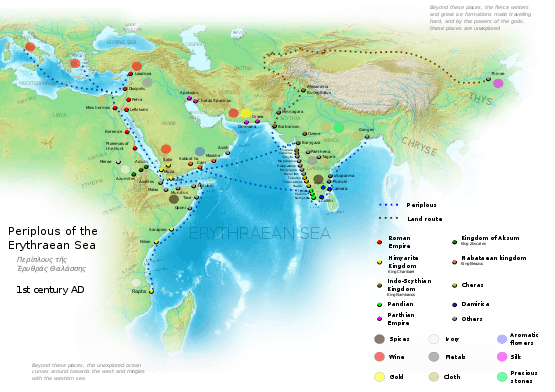Barbara (region)

Barbara, also referred to as Barbaria, referred to two ancient regions in littoral Northeast Africa. The two areas were inhabited by the Eastern Barbaroi or Baribah ("Berbers") as referred to by ancient Greek philosophers. These inhabitants were the ancestors of today's local Afroasiatic-speaking populations such as Somalis and Bejas.[1][2][3][4]
Geographers historically divided the eastern coast of Africa at large into several regions based on each region's respective inhabitants. In Somalia was Barbara, which was the land of the Eastern Baribah or Barbaroi (Berbers), as the ancestors of the Somalis were referred to by medieval Arab and ancient Greek geographers, respectively.[5][6][7] In modern-day Eritrea and Ethiopia was al-Habash or Abyssinia,[8] which was inhabited by the Habash or Abyssinians, who were the forebears of the Habesha.[9]
According to the Periplus of the Erythraean Sea, a 1st century CE travelogue written by a Greek merchant based in Alexandria, the first Barbara region extended from just south of Berenice Troglodytae in southeastern Egypt to just north of Ptolemais Theron in northeastern Sudan, whilst the second Barbara region was then located just beyond the Bab al-Mandeb up to the "Market and Cape of Spices, an abrupt promontory, at the very end of the Berber coast toward the east" found in northeastern Somalia. This second Barbara region was home to entrepôts known as the "far-side" ports.[10] Archaeological excavations led by Neville Chittick have identified the Market and Cape of Spices as the present-day Damo.[11]
Along with the neighboring Habash (Abyssinians) of Al-Habash toward the interior, the Periplus records the Berbers of the second Barbara region as engaging in extensive commercial exchanges with Egypt and Pre-Islamic Arabia. The travelogue mentions these Berbers as trading frankincense, among various other commodities, through their port cities such as Malao, Avalites, Mundus, Mosylon and Opone. Competent seamen, the Periplus' author also indicates that they sailed throughout the Red Sea and Gulf of Aden for trade. The document describes the Berbers' system of governance as decentralized, and essentially consisting of a collection of autonomous city-states.[10][12]
See also
References
- ↑ Huntingford, George Wynn Brereton (1980). The Periplus of the Erythraean Sea, Volume 2, Part 4, Issue 151. Ashgate Publishing, Ltd. pp. 59, 83 & 146. ISBN 0904180050. Retrieved 7 June 2016.
- ↑ Raunig, Walter (2005). Afrikas Horn: Akten der Ersten Internationalen Littmann-Konferenz 2. bis 5. Mai 2002 in München. Otto Harrassowitz Verlag. p. 130. ISBN 3-447-05175-2.
- ↑ F.R.C. Bagley et al., The Last Great Muslim Empires, (Brill: 1997), p.174
- ↑ James Hastings, Encyclopedia of Religion and Ethics Part 12: V. 12, (Kessinger Publishing, LLC: 2003), p.490
- ↑ F. R. C. Bagley et al., The Last Great Muslim Empires (Brill: 1997), p. 174.
- ↑ Mohamed Diriye Abdullahi, Culture and Customs of Somalia, (Greenwood Press: 2001), p. 13.
- ↑ James Hastings, Encyclopedia of Religion and Ethics Part 12: V. 12 (Kessinger Publishing, LLC: 2003), p. 490.
- ↑ Sven Rubenson, The Survival of Ethiopian Independence (Tsehai, 2003), p. 30.
- ↑ Jonah Blank, Mullahs on the mainframe: Islam and modernity among the Daudi Bohras (University of Chicago Press, 2001), p. 163.
- 1 2 Schoff, Wilfred Harvey (1912). The Periplus of the Erythraean Sea: Travel and Trade in the Indian Ocean by a Merchant of the First Century. London, Bombay & Calcutta. Retrieved 7 June 2016.
- ↑ Chittick, Neville (1975). An Archaeological Reconnaissance of the Horn: The British-Somali Expedition. pp. 117–133.
- ↑ Mohamed Diriye Abdullahi, Culture and Customs of Somalia, (Greenwood Press, 2001), pp.13-14
External links
- Periplus of the Erythraean Sea - Schoff translation